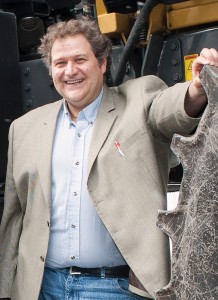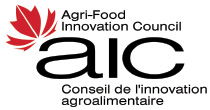
Discovery Talks
Climate Change and Air Quality
 Evaluating the Role of Forages and Grasslands on Flood and Drought Resiliency with Advanced Simulation Technology
Evaluating the Role of Forages and Grasslands on Flood and Drought Resiliency with Advanced Simulation Technology
by Dr. Steven Frey, Senior Scientist, Aquanty Inc. & Lead Scientist, Assiniboine River Basin Research Project
Advances in computational methods and computing power are making large-scale high-resolution simulations of coupled surface water, soil moisture, and groundwater flow systems an achievable reality. However, real world applications of this technology are limited. In this presentation, a fully-coupled hydrologic simulator for the Assiniboine River Basin will be demonstrated.
This simulator, which is being built by Aquanty under a project managed by the Manitoba Forage and Grassland Association, will be used to assess the influence of perennial grassland and forage land cover, along with the impact of land use change, on flood and drought resiliency within this historically high-risk region.
PDF – Steven Frey – AIC 2017 Presentation
 Carbon Sequestration in Prairie Soils and their Potential for Climate Change Mitigation
Carbon Sequestration in Prairie Soils and their Potential for Climate Change Mitigation
by Dr. Brian McConkey, Senior Research Scientist, Agriculture and Agri-Food Canada – Swift Current Research and Development Centre
Canada reported that Prairie soils in 2014 sequestered 16.4 Mt CO2equiv, reducing Canada’s net greenhouse gas emissions by 2.2%. Most of this sequestration was due to reduction in summer fallow and tillage intensity. However, there are additional opportunities to increase carbon stocks on agricultural land to reduce atmospheric
CO2.
One important sequestration effect is that from important changes in crop types and from crop yield increases. Carbon changes on the 4.8 M ha of unimproved pasture are not well known. Carbon stock changes in woody biomass in trees, such as shelterbelts, on the agricultural landscape represent another sequestration opportunity.
PDF – Brian McConkey – AIC 2017 Presentation
 Innovation is Driving Climate Change Mitigation in Canada’s Beef Sector
Innovation is Driving Climate Change Mitigation in Canada’s Beef Sector
by Dr. Karin Wittenberg, Dean, Faculty of Agricultural and Food Sciences, University of Manitoba
The Canadian beef cattle sector has shown it is possible to feed the world with a smaller environmental footprint. Today 29% fewer cattle are yielding the same amount of beef as 30 years ago on 24% less land while reducing greenhouse gas (GHG) emissions by 15% – a reduction achieved not with a single technology but through adoption of a series of innovations over the past three decades.
Industry is using advanced genetic tools to select higher yielding, higher quality feed crops, and for building more efficient breeding herds, generating both economic and environmental benefits. Improved ration formulation, animal health and implants have improved feed efficiency while reducing GHG emissions and nutrient excretion. Producers are also using data management innovations such as Beef InfoXchange System to further optimize efficiencies and reduce the environmental footprint of producing safe, affordable, high quality beef.*
* Legesse G., Beauchemin K. A., Ominski K. H., McGeough E. J., Kroebel R., MacDonald D., Little S. M. and McAllister T. A. 2016. Greenhouse gas emissions of Canadian beef production in 1981 as compared with 2011. Animal Production Science. 56(3): 153-168.
PDF – Karin Wittenberg – AIC 2017 Presentation
Panels & Forum
Climate Change and the Agricultural Sector
 Research Innovation and Opportunity
Research Innovation and Opportunity
by Dr. Mario Tenuta, Professor, Applied Soil Ecology, University of Manitoba
An argument will be made that nitrous oxide reductions from nitrogen use can be part of the Next Agricultural Policy Framework (NAPF) and the Federal Sustainable Development Strategy. This presentation will address how NAPF can include nitrous oxide reductions from use of synthetic and other fertilizer nitrogen sources to lower agriculture and food’s contribution to emissions of greenhouse gases. The presentation will also discuss
how capitalizing on carbon offsets through agricultural innovation can encourage reductions in emissions of nitrous oxide from nitrogen use in agriculture.
This presentation will also address how R&D activities can be focused to identify and encourage adoption of practices to reduce nitrous oxide emissions from soil. The reduction potential in nitrous oxide emissions will be related to potential carbon offset opportunities. Manitoba will be used as a case study.
 Precision Infrastructure for Climate Change Mitigation and Adaptation on the Agricultural Landscape and Prospects for Large-Scale Investment: A Manitoba Case Study
Precision Infrastructure for Climate Change Mitigation and Adaptation on the Agricultural Landscape and Prospects for Large-Scale Investment: A Manitoba Case Study
by Dr. Hank Venema, Planning Director, Prairie Climate Centre, International Institute for Sustainable Development
Precision infrastructure extends the precision agriculture concept to larger geographic regions and for larger scale sustainability objectives. Precision infrastructure also applies green infrastructure design principles for large-scale application on agricultural landscapes. Precision infrastructure based on multi-functional surface water retention networks addresses fundamental climate risks and opportunities including higher temperatures, more heat units, and higher frequency oscillation between flood and drought conditions.
The full value proposition of precision infrastructure investments includes flood and drought resilience, irrigation, water quality improvements, greenhouse gas mitigation and precision harvesting of high-value biomaterials. A case study from Manitoba, Canada demonstrates the logic for aggregating large numbers of precision infrastructure projects to access global capital markets, including through the Climate Bonds Initiative
certification process.
PDF – Hank Venema – AIC 2017 Presentation
 Capitalizing on the Carbon Cycle in the 21st Century
Capitalizing on the Carbon Cycle in the 21st Century
by John Wilkinson, Senior Vice President, Sustainability, GreenField Specialty Alcohols, Inc.
Humanity is struggling to end our addiction to fossilized carbon. All the while, our planet creates an endless supply of renewable carbon, courtesy of photosynthesis. Innovative farmers and companies are busy mastering each step in the renewable carbon cycle to meet our increasing need for food, fuel and materials, all the while restoring balance to our shared global ecosystem.
The presentation will focus on real world examples of how value and profit have been driven by forward thinking government policy and explore what are the next steps needed to accelerate us down this path.
